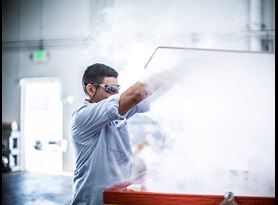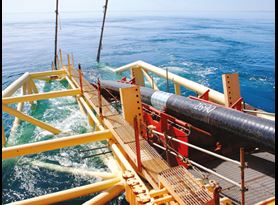As an independent testing facility accredited for IMO PSPC, the International Maritime Organization (IMO), and Performance Standards for Protective Coatings (PSPC) test protocols, Element provides testing solutions to ensure your protective coatings meet mandatory regulations for ballast water tanks and cargo oil tanks.
The IMO sets out two regulations, which are IMO Resolution MSC.215 (82) for paint and coating systems and Seawater Ballast Tanks known as the Wave Tank Test and IMO Resolution MSC.288 (87) for Cargo Oil Tanks known as a COT test.
Seawater Ballast Tank test
The wave tank test is designed to mimic a ship as it sails from port to port. The tank is designed to move to produce the effect of waves on the ship and the coatings system. Temperature changes are demonstrated as is the attachment of zinc anode to simulate cathodic protection as would be seen on the ship. The test is carried out for six months.
Cargo Oil Tank test
The COT test mimics the exposure of the coating to the inside of a crude oil tank, and so includes immersion in IMO crude and gas mixture.
The effective selection of the coating system protects sea vessels, enhances the safety of the maritime personnel, and ensures the coating systems reach their target life span.
The Element advantage
Element is accredited independently by Lloyd’s Register to perform both wave tank tests and COT tests to IMO PSPC regulations. For more information on how we can help you to adhere to the IMO PSPC requirements, please contact our experts today.
Find out how we have helped our customers with their requirements in our Subsea7 Case Study.
Webinar: Criticality of Failure Analysis in the Energy Industry
Element’s experts for Failure Analysis in the Energy industry explain during the on-demand webinar how Failure Analysis is being performed, and its benefits by providing real-life case studies from around the world.
Read MorePaints and Coatings Failures: A Guidebook on Causes and Remedies
Failure analysis is a valuable tool when investigating the root causes of asset failure, and developing a corrective action plan to ensure your paints and coatings adhere and remain intact.
READ MOREPredicting component life with corrosion modeling
Erosion within oil and gas pipelines is a serious problem. Corrosion modeling using the Computational Fluid Dynamic method can accurately predict the location of burn-throughs.
Read MoreRelated Services

ISO 12944
Element offers testing to international standards ISO 12944-6 and 12944-9 (formally ISO 20340) to aid in the selection of suitable paint systems for corrosion protection.

Salt Spray Testing
Element's Engaged Experts conduct salt spray testing, or natural salt spray (NSS) to evaluate the integrity of a coating in a corrosive environment or to test the corrosion resistance of a product or material.

Coatings Testing
Find out about our Oil & Gas coatings testing services and how we help to make certain that materials, products and pipelines are protected from corrosion, ultraviolet light, water penetration, heat, abrasion and chemicals.

NORSOK M-501
Element offers testing to NORSOK M-501 to support the selection of coating systems providing optimum protection for offshore installations.

